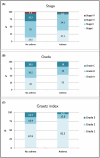Association between asthma and periodontitis: A case-control analysis of risk factors, related medications, and allergic responses
- PMID: 38853644
- PMCID: PMC11628641
- DOI: 10.1111/jre.13311
Association between asthma and periodontitis: A case-control analysis of risk factors, related medications, and allergic responses
Abstract
Aims: This study aimed to investigate the association between asthma, related allergies and medication use, and the presence and severity of periodontitis among individuals at the University of Michigan School of Dentistry.
Methods: Employing a case-control design, the study analyzed data from 892 patients, half with asthma and half without asthma. Data collection included demographics, asthma history, medication use, allergies, and periodontal examination outcomes, including probing pocket depth (PPD), mobility, furcation involvement, and radiographic bone loss (RBL). Logistic regression models assessed the relationship between asthma and periodontitis, adjusting for confounders.
Results: Asthmatic patients exhibited significantly lower odds of periodontitis (OR = 0.10, p < .001) and were less likely to present with advanced stages (OR = 0.23, p < .001) and grades of the disease (OR = 0.31, p < .001) compared to non-asthmatic patients. The study also found a higher proportion of females in the asthmatic group (67% vs. 51.8%, p < .001). Smoking was identified as a significant factor associated with periodontitis in patients with asthma, with former smokers at more than double the odds (OR = 2.28, p = .035) and current smokers at a slightly lower yet significant odds (OR = 1.87, p = .050). Additionally, asthmatic patients on adrenergic inhalers had an increased likelihood of developing periodontitis (OR = 1.76, p = .045). Allergies to codeine and latex were associated with higher odds of periodontitis, with ORs of 3.41 and 6.09, respectively.
Conclusions: Asthma was found to be associated with lower odds of periodontitis. However, this association appears to be modified by smoking habits and the use of certain asthma medications, which are related to an increased likelihood of periodontitis among asthmatic patients.
Keywords: association; asthma; disease; health care surveys; periodontitis; risk factors.
© 2024 The Author(s). Journal of Periodontal Research published by John Wiley & Sons Ltd.
Conflict of interest statement
The authors declare no potential conflicts of interest with respect to the authorship and/or publication of this article.
Figures



Similar articles
-
Association Between Asthma and Periodontitis: Results From the Korean National Health and Nutrition Examination Survey.J Periodontol. 2017 Jun;88(6):575-581. doi: 10.1902/jop.2017.160706. Epub 2017 Feb 26. J Periodontol. 2017. PMID: 28398111
-
The association between bronchial asthma and periodontitis: A case-control study in Jordan.J Asthma. 2019 Apr;56(4):404-410. doi: 10.1080/02770903.2018.1466315. Epub 2018 May 14. J Asthma. 2019. PMID: 29667525
-
Does periodontal infection have an effect on severe asthma in adults?J Periodontol. 2014 Jun;85(6):e179-87. doi: 10.1902/jop.2013.130509. Epub 2013 Nov 14. J Periodontol. 2014. PMID: 24224961
-
Smoking is a major risk factor for periodontitis.Curr Opin Periodontol. 1994:12-8. Curr Opin Periodontol. 1994. PMID: 8032453 Review.
-
Cigarette smoking: a major risk factor for periodontitis.Compendium. 1994 Aug;15(8):1002, 1004-8 passim; quiz 1014. Compendium. 1994. PMID: 7987894 Review.
Cited by
-
The Prevalence of Comorbidities in Individuals with Periodontitis in a Private Periodontal Referral Practice.J Clin Med. 2024 Dec 5;13(23):7410. doi: 10.3390/jcm13237410. J Clin Med. 2024. PMID: 39685868 Free PMC article.
References
-
- Eke PI, Borgnakke WS, Genco RJ. Recent epidemiologic trends in periodontitis in the USA. Periodontol 2000. 2020;82(1):257‐267. - PubMed
-
- Gomes‐Filho IS, Cruz SS, Trindade SC, et al. Periodontitis and respiratory diseases: a systematic review with meta‐analysis. Oral Dis. 2020;26(2):439‐446. - PubMed
-
- Brusselle GG, Koppelman GH. Biologic therapies for severe asthma. N Engl J Med. 2022;386(2):157‐171. - PubMed
-
- Settipane RA, Kreindler JL, Chung Y, Tkacz J. Evaluating direct costs and productivity losses of patients with asthma receiving GINA 4/5 therapy in the United States. Ann Allergy Asthma Immunol. 2019;123(6):564‐572. e3. - PubMed
MeSH terms
Grants and funding
LinkOut - more resources
Full Text Sources
Medical

